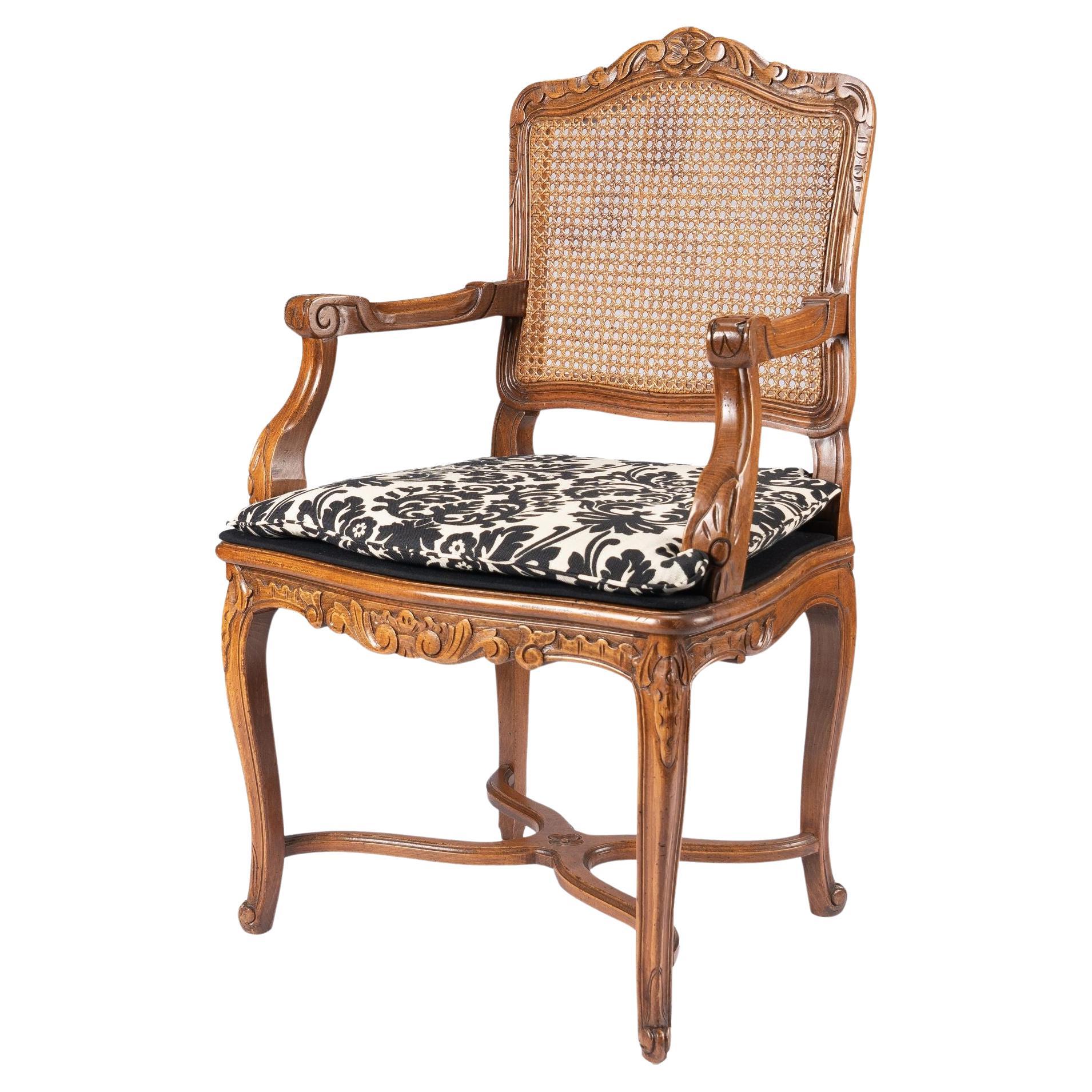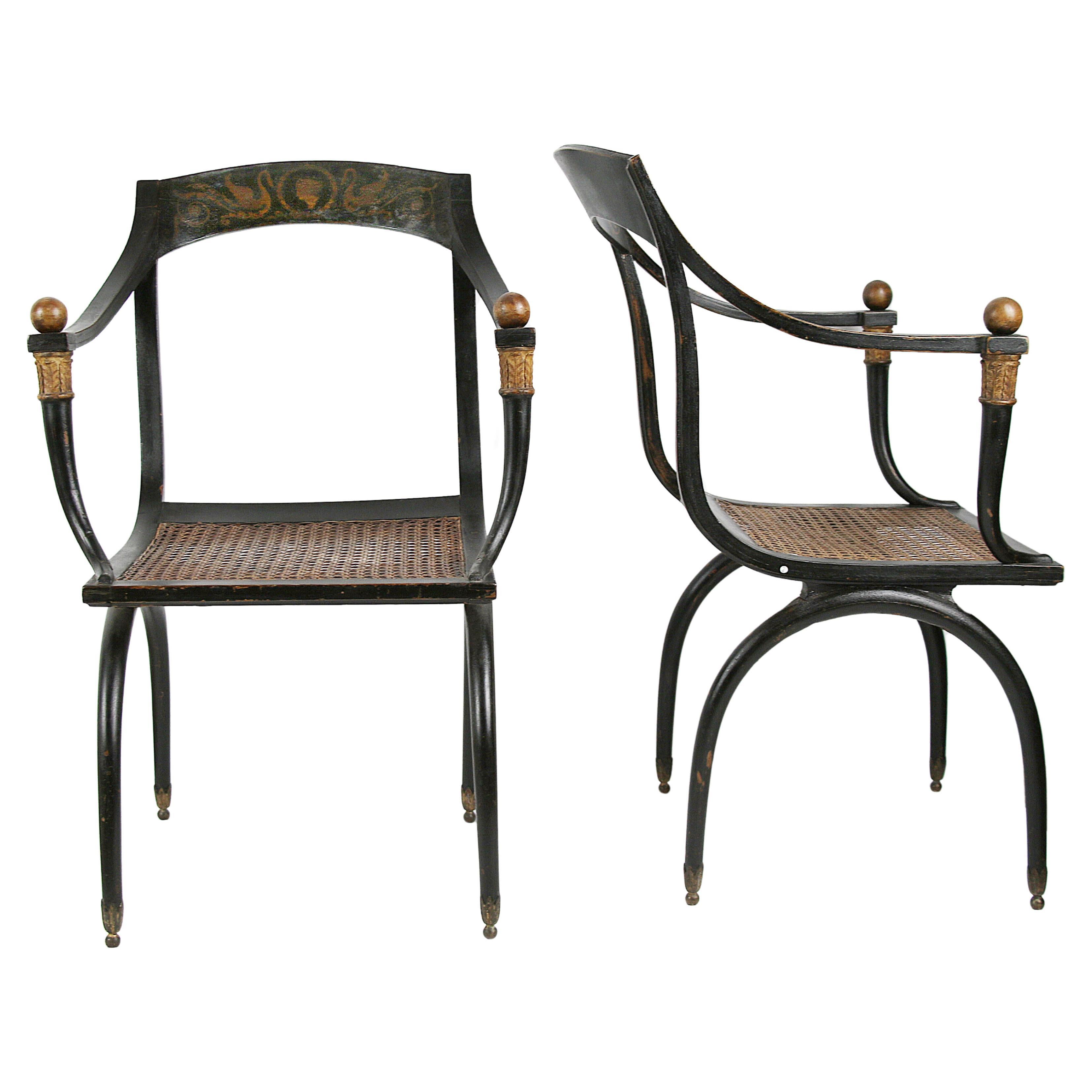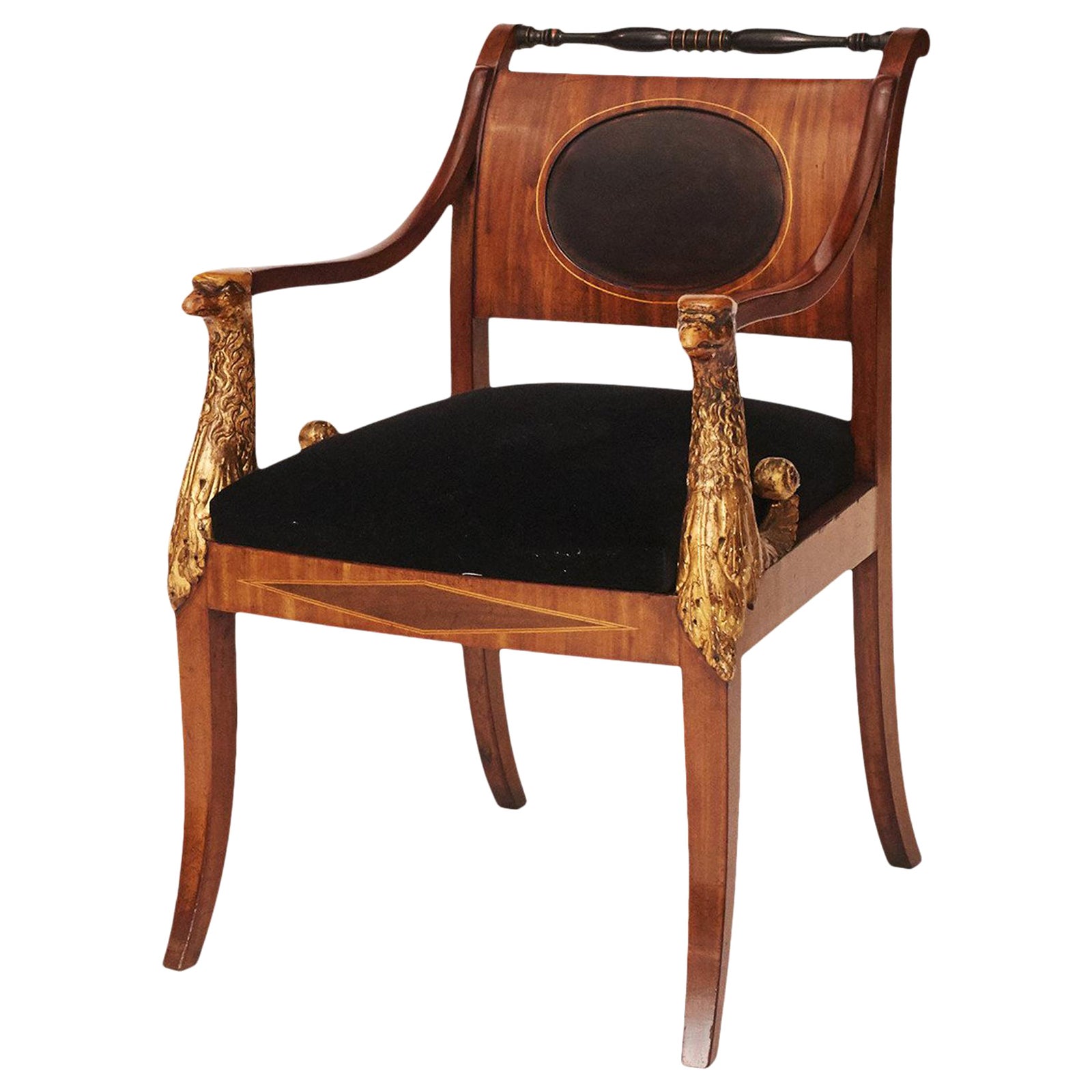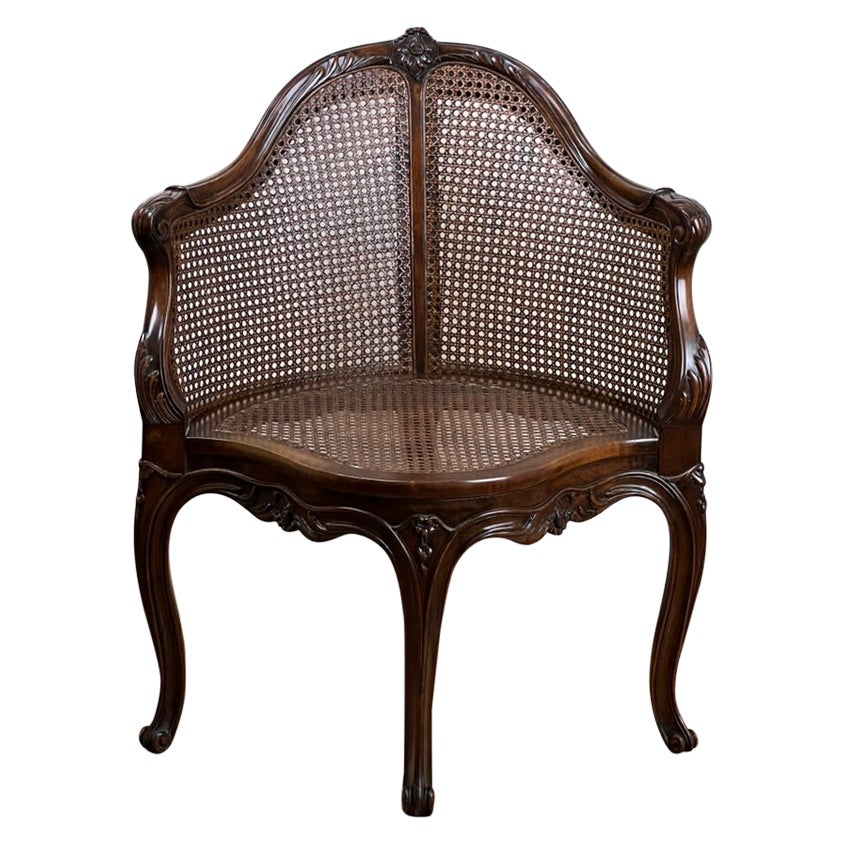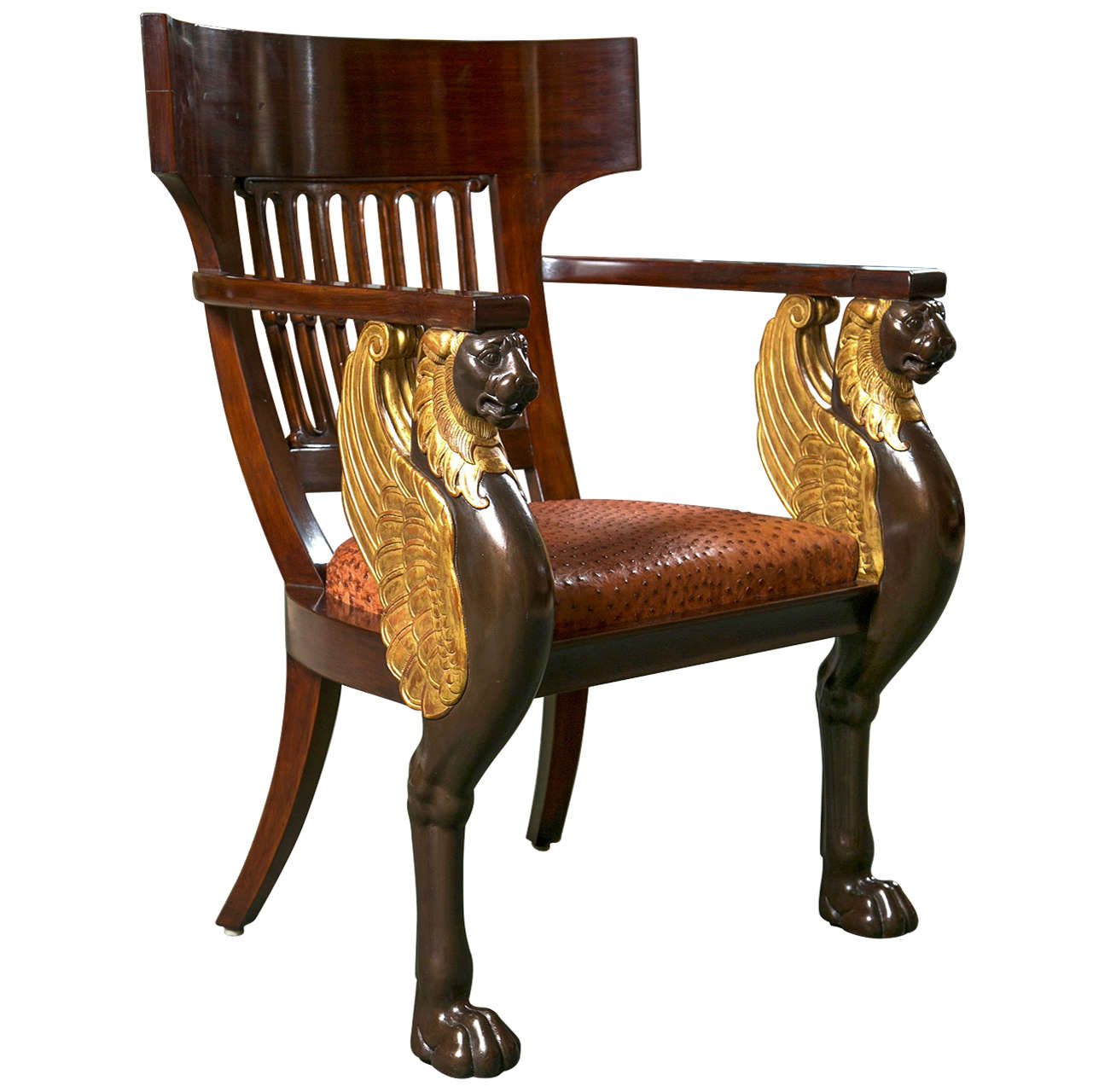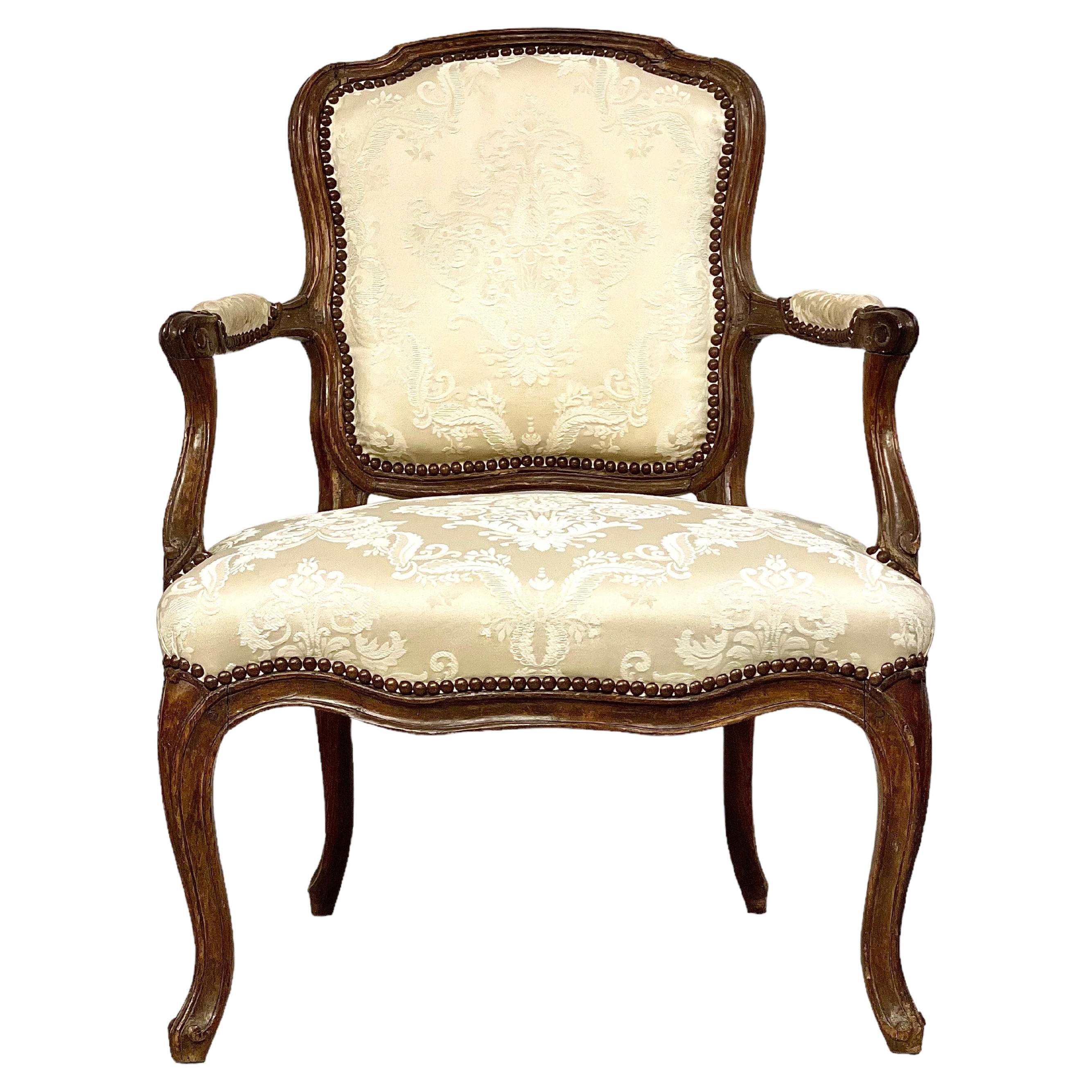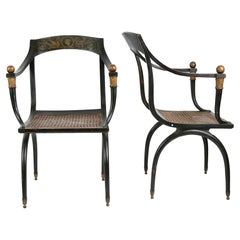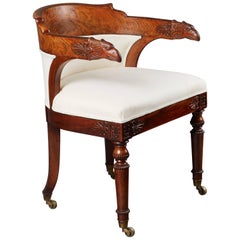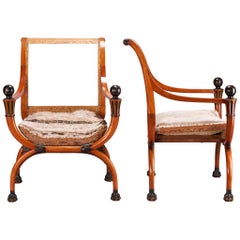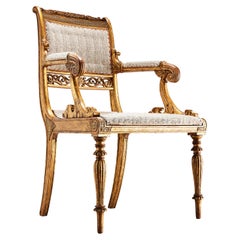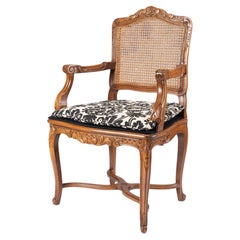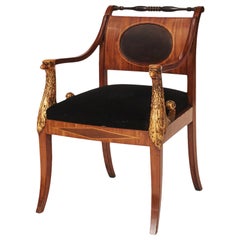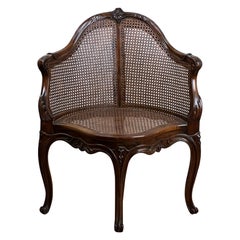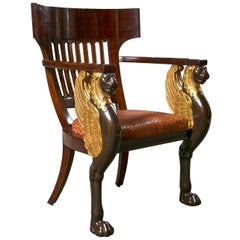Items Similar to Important Empire Early 19th Century Fauteuil by Jean-Joseph Chapuis
Want more images or videos?
Request additional images or videos from the seller
1 of 8
Important Empire Early 19th Century Fauteuil by Jean-Joseph Chapuis
$34,633.19
£25,610.17
€29,000
CA$47,572.05
A$52,897.38
CHF 27,692.73
MX$646,151.43
NOK 347,986.50
SEK 327,351.04
DKK 220,812.67
About the Item
Despite his long life, very little is known about the general production of menuisier (chairmaker) Jean-Joseph Chapuis (1765-1864) and even less about his use of bent laminates, which must be viewed as the most advanced of its kind until the appearance of Michael Thonet’s work of the 1830s.
The profound reverence for the classical world in enlightened circles in early 19th century Europe and the United States often resulted in the archaeological resurrection of the art, architecture, and design of ancient Greece and Rome. No chair employing the innovative technique of bending wood more boldly expresses this allegiance to the past than this armchair painted in le style antique and based on the ancient Roman sella curulis (folding stool); With a curved toprail decorated with putti supporting a medaillion and flanked by scrolling acanthus, the arms with ball finials, above a caned seat, on curved supports terminating in foliate gilt-metal sabots. This merger of technological innovation with fashionable aesthetics parallels the work of the American Samuel Gragg who used a bent-wood methodology to produce his body of chairs based on the ancient Greek klismos chair.
Dramatic curves such as the inverted U-form of the two pairs of legs and the sweeping curve of the continuous back and seat rail cannot be made by carving solid wood as the resulting element would be too weak to be practical. These curves could only be produced by bent laminated wood. A series of four to five solid wooden rods, each a quarter of an inch thick, were glued together, bent, bound in a caul (mold), dried, and then shaped to the appropriate form with a rasp. Jean-Joseph Chapuis was one of the first chairmakers to use the innovative technique of laminated wood to create such exaggerated curves. This technique was taken up and fully exploited by Michael Thonet after 1830. In the second half of the 19th century bentwood furniture became highly popular.
Identical models of this fauteuil were among the furnishings of the Royal Palace at Laeken, near Brussels, during the early years of the Napoleonic occupation. As a result, the maker of this chair was thought to have been the Parisian ébéniste Claude Chapuis, but Denise Ledoux-Lebard has proved that Jean-Joseph Chapuis of Brussels was in fact responsible for this design. The models installed at Laeken are painted white.
Comparable examples are in the collection of the Metropolitan Museum, New York, Victoria & Albert Museum, London, Neue Pinakothek, München, Vitra-Design Museum, Weil am Rhein.
- Creator:Jean Joseph Chapuis (Cabinetmaker)
- Dimensions:Height: 35.04 in (89 cm)Width: 21.66 in (55 cm)Depth: 21.66 in (55 cm)Seat Height: 16.54 in (42 cm)
- Style:Empire (Of the Period)
- Materials and Techniques:
- Place of Origin:
- Period:
- Date of Manufacture:circa 1805
- Condition:Wear consistent with age and use. Minor losses.
- Seller Location:Worpswede / Bremen, DE
- Reference Number:Seller: 19961stDibs: LU981415424062
About the Seller
5.0
Recognized Seller
These prestigious sellers are industry leaders and represent the highest echelon for item quality and design.
Established in 1979
1stDibs seller since 2013
27 sales on 1stDibs
Typical response time: 22 hours
- ShippingRetrieving quote...Shipping from: Worpswede / Bremen, Germany
- Return Policy
Authenticity Guarantee
In the unlikely event there’s an issue with an item’s authenticity, contact us within 1 year for a full refund. DetailsMoney-Back Guarantee
If your item is not as described, is damaged in transit, or does not arrive, contact us within 7 days for a full refund. Details24-Hour Cancellation
You have a 24-hour grace period in which to reconsider your purchase, with no questions asked.Vetted Professional Sellers
Our world-class sellers must adhere to strict standards for service and quality, maintaining the integrity of our listings.Price-Match Guarantee
If you find that a seller listed the same item for a lower price elsewhere, we’ll match it.Trusted Global Delivery
Our best-in-class carrier network provides specialized shipping options worldwide, including custom delivery.More From This Seller
View AllJean-Joseph Chapuis Rare Pair of Empire parcel-gilt japanned Fauteuils
By Jean Joseph Chapuis
Located in Worpswede / Bremen, DE
Despite his long life, very little is known about the general production of menuisier (chairmaker) Jean-Joseph Chapuis and even less about his use of bent laminates, which must be viewed as the most advanced of its kind until the appearance of Michael Thonet’s work of the 1830s.
The profound reverence for the classical world in enlightened circles in early nine-teenth-century Europe and the United States often resulted in the archaeological resurrection of the art, architecture, and design of ancient Greece and Rome. No chair employing the innovative technique of bending wood more boldly expresses this allegiance to the past than this armchair painted in le style antique and based on the ancient Roman sella curulis (folding stool); With a curved toprail decorated with putti supporting a medaillion and flanked by scrolling acanthus, the arms with ball finials, above a caned seat, on curved supports terminating in foliate gilt-metal sabots. This merger of technological innovation with fashionable aesthetics parallels the work of the American Samuel Gragg...
Category
Antique Early 19th Century Belgian Empire Armchairs
Materials
Bentwood
Neoclassical Empire Early 19th Century Mahogany Desk Armchair
Located in Worpswede / Bremen, DE
An unusual North European mahogany desk armchair with original brass castors. Fully carved armrests with eagle heads, the design probably by a designer from Berlin or Copenhagen (e.g...
Category
Antique Early 19th Century German Empire Armchairs
Materials
Brass
Rare Pair of French Directoire Fauteuils en Curule, Paris, circa 1800, G. Jacob
By Georges Jacob
Located in Worpswede / Bremen, DE
These finely sculpted fauteuils supported by curule-form bases, reflect the 'antique' influence of the excavations at Pompeii and Herculaneum during the 18th century. This form based on the antique Roman sella...
Category
Antique Early 19th Century French Neoclassical Armchairs
Materials
Mahogany
Early 19th Century Danish Giltwood Armchair by Gustav Friederich Hetsch
Located in Worpswede / Bremen, DE
A very decorative and large giltwood armchair after a design by the famous Danish Architect Gustav Friedrich Hetsch, (1788-1964). The German born architect worked mostly in Copenhage...
Category
Antique Early 19th Century Danish Empire Armchairs
Materials
Giltwood
Unusual Early 19th Century Danish Mahogany Armchair Attributed to Hetsch
Located in Worpswede / Bremen, DE
This chair is of highly elaborate design and exceptional craftsmanship. Open arms enclosing ornamental stylized foliage. Pierced turned reeded front legs, drop in seat and padded bac...
Category
Antique Mid-19th Century Danish Romantic Armchairs
Materials
Mahogany
Grand German Late 17th Century Baroque Walnut Armchair
Located in Worpswede / Bremen, DE
Fine tall German late 17th century Baroque walnut throne armchair with a rectangular arched padded back and seat covered in 17th century Gobelin depicting ‘Susanna and the Elders’ wi...
Category
Antique Late 17th Century German Baroque Armchairs
Materials
Tapestry, Walnut
$10,748 Sale Price
53% Off
You May Also Like
French Louis XVl style fauteuil, c. 1900's
Located in Kenilworth, IL
Academic Revival, Louis XVI style fauteuil with a caned seat & back panel, fitted with an upholstered seat cushion and upholstered seat platform.
France, early 20th century.
Dimensi...
Category
20th Century French Louis XVI Armchairs
Materials
Upholstery, Cane, Wood
$1,200 Sale Price
25% Off
Elegant Danish Empire Armchair, circa 1810
Located in Kastrup, DK
Elegant and decorative Empire armchair. Made in mahogany, with light wood inlaid (lemon tree). Oval backboard in ebonised wood. Front of arms in the form of wooden cut grippers with ...
Category
Antique 1810s Danish Empire Armchairs
Materials
Mahogany, Velvet, Wood, Fruitwood
Antique French Napoleon III Desk Chair (Fauteuil de Bureau) c. Late 19th Century
Located in Westfield, MA
This fine antique French desk chair from the Napoleon III period blends refinement and function with the curving, sculptural lines typical of late 19th-century French design. Often r...
Category
Antique Late 19th Century French Napoleon III Office Chairs and Desk Chairs
Materials
Walnut
French Empire Style Chair by Frederick Victoria
Located in Stamford, CT
A French Empire style chair made by Frederick Victoria with ostrich leather seat.
Category
20th Century French Empire Armchairs
Materials
Wood
18th Century Louis XV Period Fauteuil by Mathieu BAUVE
Located in LA CIOTAT, FR
A luxurious Louis XV period armchair in beautifully carved and moulded walnut, with ornate scroll-carved arm rests and supports. This elegant 'Fauteuil à la Reine' dates from the 18t...
Category
Antique 18th Century French Louis XV Armchairs
Materials
Walnut
Antique French Vernis Martin Salon Open Armchair Druce & Co 19th Century
Located in London, GB
A superb French walnut Vernis Martin salon open armchair, Circa 1870 in date.
The shield shaped back painted with a scene of lovers in a garden, with rose decoration to the arms. With brass plaque for the renowned Victorian retailer Druce & Co., of London.
The seat has been reupholstered in sumptuous tan leather, by Moore & Giles, with individual brass studs.
The quality and attention to detail throughout is second to none.
Add a touch of unparalleled style to your home.
Condition:
In excellent condition having been beautifully cleaned, waxed and reupholstered in our workshops, please see photos for confirmation.
Dimensions in cm:
height 104 x width 57 x depth 55
Dimensions in inches:
height 3 foot, 5 inches x width 1 foot, 10 inches x depth 1 foot, 10 inches
Druce & Co of 68 Baker Street, Portman Square, London, were established in the 1840's and were both cabinet makers and retailers of second-hand furniture. In the Marlebone Trade Directory of 1853, they described themselves as 'Furnishers,Upholsterers and Upholders for clients of discernment'.
Vernis Martin
is a lustrous lacquer substitute widely used in the 18th century to decorate furniture and such personal articles as brisé fans...
Category
Antique 1870s French Armchairs
Materials
Walnut
More Ways To Browse
Early American Empire Furniture
Vitra Design Museum
Provence Armchairs
Bent Lamination
Empire Style Armchair
19th Century Folding Chair
Caned Folding
Thonet Bentwood 19th Century
19th Century Bentwood Chairs
Ancient Roman Chairs
Woven Cane Stool
Early American Stool
Greek Klismos Chair
Antique Wooden Canes
Fauteuil Gilt
Century Wood Carving Belgium
Gilt Cane Chair
White Bentwood Chairs
